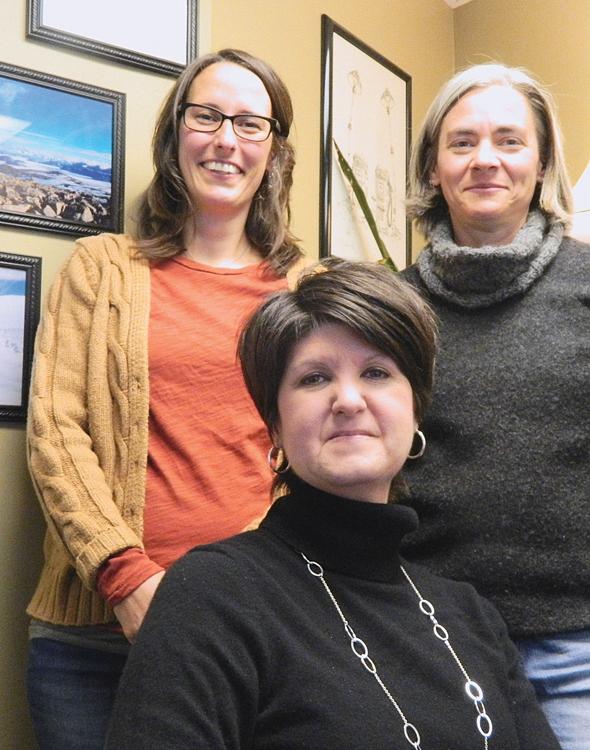Headline News
Improving community safety and well-being
March 24, 2016

Three of the five Addictions and Mental Health Services H&PE counsellors located at the Bancroft office: Patricia Liverseed, Laurie Hall and Susan Poste. Persons seeking help with addictions or mental health can call 310-OPEN (24 hours) for assistance from a mental health worker.JIM EADIE Special to This Week
By Jim Eadie
In 2014, the Town of Bancroft was chosen for a pilot “community and safety and wellbeing” project. This project, assisted by Dr. Hugh Russell, envisioned community agencies, citizens, businesses, the County of Hastings and the police working more collaboratively than before.
The original idea was trotted out by the police representatives at municipal council meetings as a potential cost saving measure to address ballooning policing costs, but everyone now seems to concede that may not be the case.
Residents of Ontario pay the highest policing costs in the country by far, and as the Association of Municipalities Ontario (AMO) Policing
Modernization Task Force noted recently: “For the last decade, police spending has been growing at three times the rate of inflation. This growth is starving other critical public services which also play a role in keeping us safe and healthy.”
Currently the Province of Ontario is holding a series of consultations regarding their intention to update the Police Services Act. Community safety and well-being planning, and modernizing what the police do, are on the consultation agenda. A local consultation was held in Faraday Township a few weeks ago.
The current OPP acting detachment commander, Staff Sgt. Tim Spence, notes that the Town of Bancroft is a few jumps ahead of the process already, with its Council’s Community Safety and Wellbeing Committee. “We are currently in the process of setting up a Risk Mitigation Table,” he said. This would be a formal meeting place where police could come together with social service agencies including addictions and mental health workers.
“These risk mitigation tables are evolving across the province, but the purpose is to sit together and look at the underlying conditions and problems faced by an individual or family, and while maintaining confidentiality, address what it is they really need,” said Spence. “A collective look at underlying issues and concerns will get them the needed help and support. We are not the lead agency; this will be led by the municipality.”
Tim Pomfret is the director of programs and operations for Addictions and Mental Health Services including the north Hastings area.
“We evolved from the folding of two programs together: addictions and mental health; that was an excellent move,” he said. “Often, but not always, mental health and addictions issues intersect.”
“Concurrent Disorder Workers are now a new specialty,” he added. “They deal with both issues in the same appointment. We have really tried to address the northern area of the county, and presently have five counsellors in the Bancroft office.”
“This is a really good concept,” Pomfret asserted, but he has a couple of niggling worries.
“There is a need to consider privacy legislation,” he said. “We are required by law to protect a person’s health information; we are not at liberty just to talk about them.” He insists that the process be designed to respect privacy, and seek out informed consent when it is required.
“I would also like to see more familiarity with our own community services,” he said. “Orientation sessions would be very helpful for police officers and municipal leaders to know what services they have here, and how to use them.”
The Association of Municipalities of Ontario has some key concerns as well. The organization wonders if municipal councils assume responsibility for the cooperation and actions of agencies over which they have little or no control. Currently 30 per cent of calls to the police deal with mental health issues. AMO suggests that reducing the reliance on police should be a key goal, and strengthening of existing mental health programs should occur. In addition to specialized training for police officers, AMO supports the lateral entry of mid-career professionals with specialized skills into police services.
“I am optimistic about progress,” said Sgt. Spence. “This is a new process, but it is gaining momentum … and I am very confident.”




















